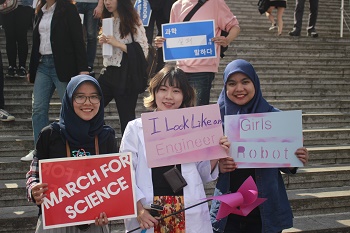

For 28-year-old Lee Se-ri, she regards “Science Communicator” as the most suitable term for her career though she specializes in robotics. Like the word “robot” in her vocation, she has been imbued with a fascination for robotics since her first encounter in college.
As a freshman in Kookmin University, Lee participated in a robot soccer club dubbed KUDOS short for Kookmin University Dream of Soccer. The club aimed to create humanoid robots capable of mimicking human movements playing soccer. Her team broadened their research to skiing robots during the Pyeongchang Olympics.
With this as her starting point, she went on engaging in various fields of robotics. Lee’s internship at Robotis, a company selling robots and robot parts, taught her how robot markets function since many participants in robotic competitions in Korea buy from this company. Here, she developed a sense of how robots are practically utilized.
As a member of Girls Robot, which is a company promoting networking between female scientists, she campaigned for activities focusing on women in the fields of engineering and science. By communicating with other female engineers, Lee realized that the lack of women in science was due to the severed work experience in cases of marriage as well as a comparatively low interest in such disciplines than in liberal arts.
Lee specialized in soft robotics during her training at Seoul National University’s Soft Robotics Research Center (SRRC). Unlike hard robots, which are of firm exterior appearance like Iron Man, soft robots are those of more diverse and flexible shapes. As a researcher in this lab, she studied wearable robots.
“The fact that these robots can function and charge with only human movements through clothing elevated my thoughts about robots to a broader aspect,” Lee said.
It was after her experience as a researcher that she started working as a communicator in the field of science. In an event called Fame Lab Korea, she gave the audience a three-minute introduction to robots. Also, through what she named “science busking,” she presented experiments in an entertaining way. Her experiences in these events taught her that a fine educator is different than a superb researcher. Lee continues to ponder which method is most effective in getting scientific contents across to listeners.
Recently, she launched “Moonlight,” a science-art theater company. In collaboration with the Ministry of Science and ICT as well as the Korea Foundation for the Advancement of Science & Creativity, her company created a shadow musical puppet show using automata which performed from Feb. 19 to 23.
“It was a one-of-a-kind experience to create a shadow play that used robots instead of puppets,” Lee commented. “The process of organizing new projects with robots is always challenging. Some may have to repeat experiments over and over for a satisfying result, or others would need to come up with ingenious ideas. As for me, I do best in supporting projects throughout the journey like a shadow.”
Lee ended by saying that although it may seem unrealistic, creating robots which arouse emotions from humans is her ultimate goal. Robots may never be capable of sharing emotions, but she hopes that her robots will help people to a point at which humans feel they are alive.

